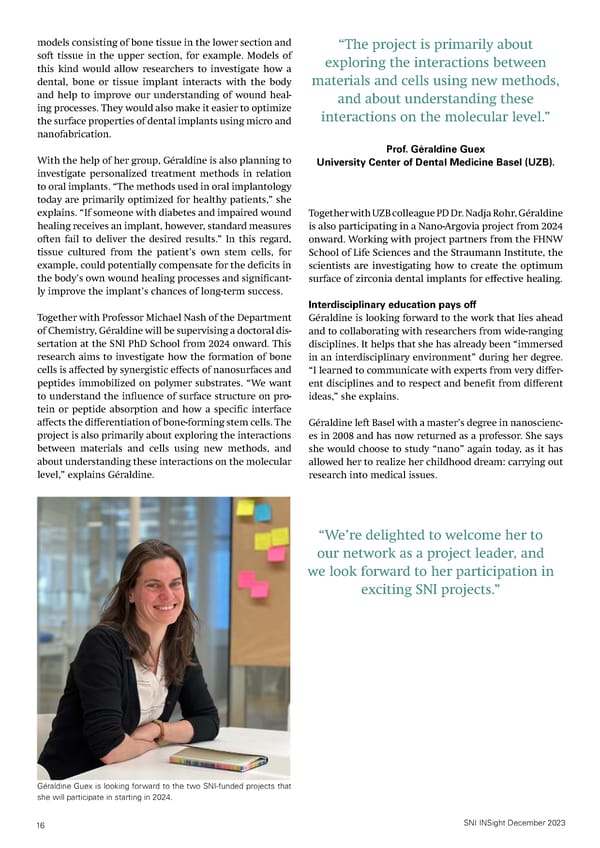models consisting of bone tissue in the lower section and “The project is primarily about soft tissue in the upper section, for example. Models of exploring the interactions between this kind would allow researchers to investigate how a dental, bone or tissue implant interacts with the body materials and cells using new methods, and help to improve our understanding of wound heal- and about understanding these ing processes. They would also make it easier to optimize interactions on the molecular level.” the surface properties of dental implants using micro and nanofabrication. Prof. Géraldine Guex With the help of her group, Géraldine is also planning to University Center of Dental Medicine Basel (UZB). investigate personalized treatment methods in relation to oral implants. “The methods used in oral implantology today are primarily optimized for healthy patients,” she explains. “If someone with diabetes and impaired wound Together with UZB colleague PD Dr. Nadja Rohr, Géraldine healing receives an implant, however, standard measures is also participating in a Nano-Argovia project from 2024 often fail to deliver the desired results.” In this regard, onward. Working with project partners from the FHNW tissue cultured from the patient’s own stem cells, for School of Life Sciences and the Straumann Institute, the example, could potentially compensate for the de昀椀cits in scientists are investigating how to create the optimum the body’s own wound healing processes and signi昀椀cant- surface of zirconia dental implants for e昀昀ective healing. ly improve the implant’s chances of long-term success. Interdisciplinary education pays off Together with Professor Michael Nash of the Department Géraldine is looking forward to the work that lies ahead of Chemistry, Géraldine will be supervising a doctoral dis- and to collaborating with researchers from wide-ranging sertation at the SNI PhD School from 2024 onward. This disciplines. It helps that she has already been “immersed research aims to investigate how the formation of bone in an interdisciplinary environment” during her degree. cells is a昀昀ected by synergistic e昀昀ects of nanosurfaces and “I learned to communicate with experts from very di昀昀er- peptides immobilized on polymer substrates. “We want ent disciplines and to respect and bene昀椀t from di昀昀erent to understand the in昀氀uence of surface structure on pro- ideas,” she explains. tein or peptide absorption and how a speci昀椀c interface a昀昀ects the di昀昀erentiation of bone-forming stem cells. The Géraldine left Basel with a master’s degree in nanoscienc- project is also primarily about exploring the interactions es in 2008 and has now returned as a professor. She says between materials and cells using new methods, and she would choose to study “nano” again today, as it has about understanding these interactions on the molecular allowed her to realize her childhood dream: carrying out level,” explains Géraldine. research into medical issues. “We’re delighted to welcome her to our network as a project leader, and we look forward to her participation in exciting SNI projects.” Géraldine Guex is looking forward to the two SNI-funded projects that she will participate in starting in 2024. SNI INSight December 2023 16
 SNI INSight December 2023 Page 15 Page 17
SNI INSight December 2023 Page 15 Page 17